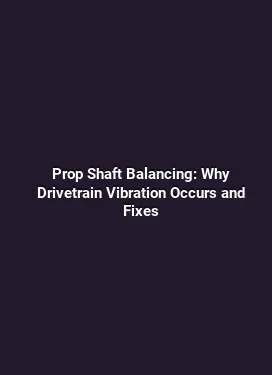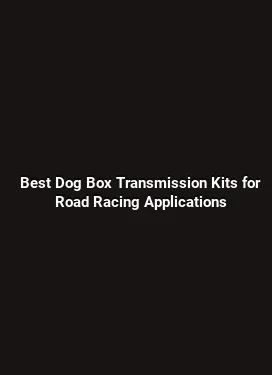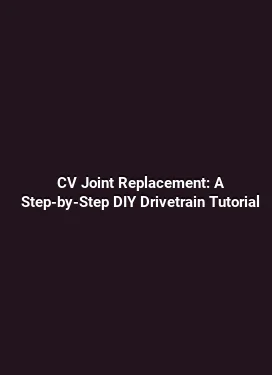Performance Axles: Upgrading Half-Shafts for High-Torque Builds
Understanding the Demands of High-Torque Drivetrains

High-torque drivetrain setups push beyond the limits of stock half-shafts, requiring a careful balance between strength, weight, and rotational inertia. In vehicles that see aggressive acceleration, track use, or heavy towing, half-shafts must resist bending, torsional stress, and spline wear while maintaining reliable power transfer to the wheels. The fundamental challenge is to keep the CV joints properly lubricated and the spline engagement secure under peak torque without excessive heat buildup that can degrade lubricants and degrade material properties over time.
Torque transmission happens at the interface where the shaft engages the wheel hub or constant-velocity joint. The most critical factors are material yield strength, fatigue life, spline geometry, and the ability to dissipate heat generated by friction and high-speed rotation. When torque spikes occur, especially during launch or downshifting under load, the half-shafts experience alternating stress cycles that can initiate microcracks if the design isn’t robust enough. In practical terms, a well-designed upgrade preserves drive feel, reduces under-acceleration flex, and maintains CV joint life even in harsh launch conditions.
Torque and Stress Analysis

Understanding torque distribution along the half-shaft helps determine where failures are most likely to occur. Finite element analysis (FEA) in development environments often highlights hotspots near spline regions, flange interfaces, and CV joint housings. Translating this into a street-legal yet high-performance build means selecting a half-shaft with a higher yield strength, improved fatigue resistance, and reinforced spline cores. Real-world observations show that even small gains in shaft torsional stiffness can translate into smoother power delivery and reduced parasitic losses during aggressive shifts.
Choosing the Right Half-Shafts and Materials
The choice of material and construction method profoundly impacts durability. Common options include forged steel, chromoly alloys, and proprietary heat-treated steels designed for high-torque applications. A crucial decision is whether to upgrade the entire half-shaft or opt for billet or hollow-core designs that balance weight savings with structural integrity. For many high-torque builds, the goal is to achieve a higher fatigue limit without a substantial increase in unsprung mass, which can negatively affect handling and ride quality.
Material science trends in performance axles emphasize heat treatment, surface hardening, and improved spline engagement geometry. Surface hardening, such as case hardening or induction hardening, raises the outer layer’s hardness while preserving core toughness. This reduces wear on the spline teeth, minimizes micro-skip under load, and extends the life of CV joints by maintaining consistent lubrication channels. Modern half-shafts also consider the interaction with lubricants, where sealed CV joints and precise internal clearances reduce churning losses and keep lubrication effective under high RPMs.
Material Science Behind Half-Shafts
Chromoly or high-strength alloy steels are common choices for performance half-shafts because they provide a superior strength-to-weight ratio and improved fatigue resistance. The heat treatment process, including quenching and tempering, sets a balance between hardness and toughness. Spline design—such as increased number of splines or deeper engagement—improves torque distribution and reduces the risk of slip. Manufacturers also explore surface coatings that reduce friction and wear at the CV joint interface, contributing to cooler operation and extended service intervals.
Installation Considerations and Safety Precautions
Upgrading half-shafts is not simply a swapping exercise. Proper installation requires attention to axial play, endplay, and proper lubrication of CV joints. Some aftermarket options demand precision torque specs for hub nuts, as overtightening can warp components or preload bearings, while under-tightening may allow misalignment and vibration. Correct axial alignment ensures consistent CV joint articulation through suspension travel, which is especially important on performance builds that see track use or aggressive street driving.
During install, verify spline engagement depth and confirm that the CV joint boot clamps are secure. A failing boot can lead to contaminants entering the joint and accelerated wear, effectively negating the benefits of a higher-strength shaft. In addition, inspecting the drive shaft balance and ensuring proper wheel alignment helps minimize vibrations that could otherwise compromise the life of the upgraded half-shafts and adjacent driveline components.
Installation Steps and Best Practices
Begin with a complete inspection of the current driveline layout, noting the axle length, CV joint type, and hub compatibility. Remove the stock half-shafts and compare lengths, spline counts, and flange interfaces to the new parts. When mounting the upgraded half-shafts, use anti-seize compounds where appropriate to facilitate future disassembly, and apply the manufacturer’s recommended torque values to fasteners. After installation, perform a careful test drive to confirm smooth engagement and listen for any abnormal noises that might indicate misalignment or binding at peak articulation.
Performance Benefits and Real-World Outcomes
Upgrading half-shafts for high-torque builds can yield several tangible performance benefits. First, improved torsional stiffness helps reduce driveline flex under hard acceleration, leading to more consistent throttle response and improved traction control. Second, better spline engagement translates into reduced risk of slip during aggressive launches; drivers often report more repeatable 0-60 times and more stable reaction to throttle input at the limit. Third, enhanced durability means longer intervals between maintenance, which is especially valuable for track-driven or off-road applications where service windows are limited.
In terms of driveline dynamics, the weight penalty of stronger shafts can be offset by optimized geometry and advanced materials. The result is a net gain in performance without compromising ride quality significantly. Additionally, when paired with appropriate differential tuning and calibrated performance tires, upgraded half-shafts contribute to more predictable corner exits and improved yaw stability under high torque. Owners who track their vehicles frequently often adopt a holistic approach that includes upgraded wheel hubs, stronger CV boots, and enhanced lubrication strategies to maximize the longevity of the entire drivetrain assembly.
Real-World Scenarios and Notes
For drag-focused builds, the emphasis lies on preventing axle wrap and maintaining tire contact with the ground during launch. Upgraded half-shafts, combined with a robust limited-slip differential, can help manage torque delivery more effectively and reduce wheel hop. In endurance or road-course environments, the durability gains contribute to consistent lap times and lower maintenance overhead. In off-road conditions, sheer strength and resistance to debris intrusion become critical, and properly sealed CV joints ensure reliable operation under mud, sand, and water exposure.
Maintenance and Longevity in Demanding Applications
Long-term reliability hinges on proactive maintenance. Regular inspection of spline wear, CV boot integrity, and boot lubrication is essential. As high-torque use cases increase heat generation in the driveline, verifying lubrication levels and replacement intervals becomes more critical than for stock setups. Monitoring for abnormal noises, vibration, or changes in drive feel can allow preventative maintenance before a catastrophic failure occurs. An effective maintenance plan also includes checking the hub bearings, brake rotor runout, and wheel alignment, since any misalignment can accelerate wear on upgraded half-shafts.
Preventive measures extend beyond routine checks. Cleanliness during installation, compatibility checks with the existing differential and wheel hubs, and choosing high-quality hardware with compatible tolerances all contribute to maximizing lifespan. A well-balanced drivetrain reduces peak loads on half-shafts and CV joints, enabling more predictable performance during aggressive driving sessions and reducing the likelihood of sudden failures in extreme conditions.
Maintenance Routines for High-Torque Drivetrains
Implement a quarterly inspection schedule that focuses on CV joint boots, grease seals, and spline engagement. For vehicles used in demanding environments, extend inspections to monthly checks during peak driving seasons. If signs of wear appear—such as grease leakage, crack formation on boots, or unusual play in the shaft—address them promptly. Use high-temperature lubricants and gear oils specified for the differential and CV joints, ensuring compatibility with the upgraded shaft materials. Finally, maintain accurate torque records for all fasteners to ensure consistent performance over time.
Endnotes on Longevity
Choosing a reputable manufacturer, ensuring proper installation, and integrating the upgrade with a holistic driveline strategy are the cornerstones of lasting performance. When combined with tuned suspension, calibrated differential behavior, and appropriate tire choices, upgraded half-shafts deliver consistent, reliable torque transfer that endures under demanding use cases while keeping the vehicle’s handling characteristics within predictable, controllable bounds.






